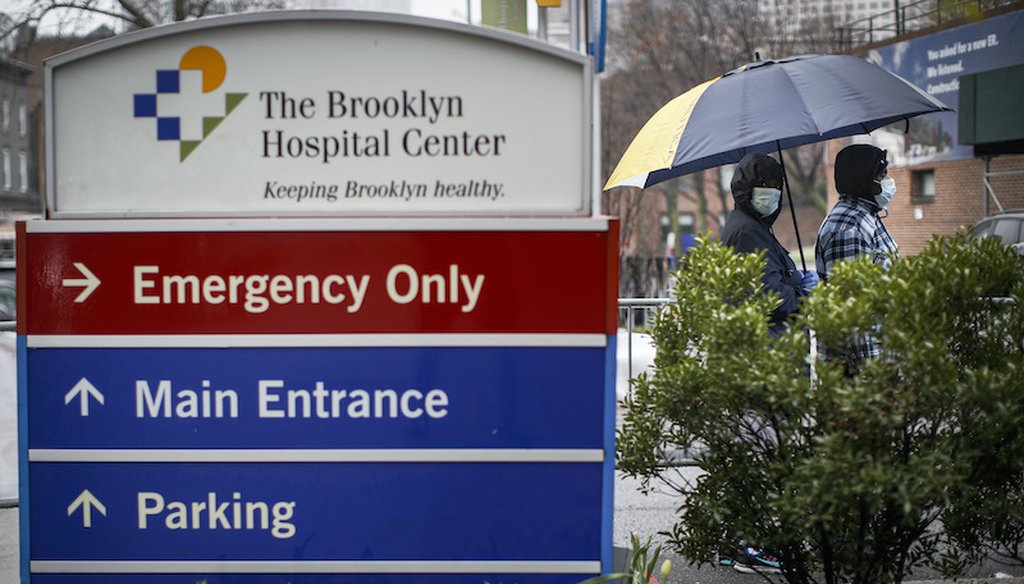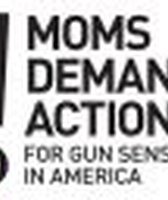Stand up for the facts!
Our only agenda is to publish the truth so you can be an informed participant in democracy.
We need your help.
I would like to contribute

Patients wait for a COVID-19 test at Brooklyn Hospital Center in New York. (AP Photo/John Minchillo)
If Your Time is short
-
Federal support to build state and local capacity to manage a new viral crisis fell by 50% after 2003.
-
The decline in federal aid spans three presidencies and many sessions of Congress.
-
President Donald Trump sought $100 million in cuts that would have made the situation harder.
President Donald Trump’s critics have charged that he undermined efforts that could have helped the nation respond faster and better to the coronavirus. He’s been criticized for downgrading the focus on pandemic threats on the National Security Council and chastised for seeking budget cuts at the Centers for Disease Control and Prevention.
That isn’t the full story of U.S. pandemic preparedness.
The broader picture is that money to prepare for this day has steadily dwindled over the past 15 years — across three presidents and many sessions of Congress.
The funds for pandemics remained about the same under Trump (and would have been lower if his budgets were enacted). But compared with where funding stood in 2003, support to build state and local capacity has fallen by half.
As hospitals and public health agencies aimed for leaner, more efficient operations, the combination of fewer federal dollars and market pressures left them with little cushion to meet the explosive demands of the novel coronavirus.
Sign up for PolitiFact texts
Over the years, Washington put more emphasis on fighting predictable problems, like the seasonal flu, and outright aggression in the form of chemical, biological and radiological terrorism.
Sandro Galea, dean of Boston University’s School of Public Health, said people like him have been hamstrung in the debate.
"Public health has been on the defensive," Galea said. "There's been no space except for talk of bioterrorism. The discussion about investing in the public health system has been utterly sidelined."
The long-term decline
Frontline readiness for a pandemic depends on many factors.
There have to be enough people with the right skills; enough beds, equipment and materials to treat patients; and the right practices to coordinate efforts across a region. Federal money helps support all of that.
The Centers for Disease Control and Prevention distributes grants to state and local public health agencies, labs and hospitals. In nominal dollars, the funding for the CDC’s Public Health Emergency Preparedness grants went from $939 million in 2003 to $675 million in 2020.
Private health providers get money through a hospital preparedness program within the Health and Human Services Department. It helps local coalitions of hospitals, public health agencies and emergency managers plan and get ready for a sudden health threat. That money went from $515 million to $275 million in the same 17-year period.
Corrected for inflation, combined spending went from over $2 billion in 2003 to a bit under $1 billion in 2020.
These programs came to the fore after the Sept. 11 attacks when concern over bioterrorism spiked. For lawmakers, the concern was personal — letters tainted with anthrax reached Capitol Hill.
But the money gradually faded, and the capacity of state and local public health departments and labs did not keep pace with the likelihood of a viral disease like COVID-19.
"Health departments can't retain workforce or modernize their disease surveillance and laboratory capacity without adequate, long-term funding," said Dara Lieberman, director of government relations with Trust for America’s Health, a public health advocacy group. "Today, we’re paying the price."
Local health systems needed to do their part, but the federal government was uniquely positioned to help.
"The purchasing power of the federal government is second to none, and it has failed to stockpile or otherwise negotiate pipelines to get access to the personal protective gear and medical equipment that it has known with certainty would be needed in a respiratory pandemic," said Ellen Carlin at Georgetown University’s Center for Global Health Science and Security.
But the news hasn’t been all bad.
After the Ebola scare in 2014, Washington and the states showed renewed interest in preparing for a naturally occurring viral threat.
Congress provided a bit of extra money, and according to a Health and Human Services study the improvement was striking: In 2014, about 70% of hospital administrators said they were unprepared for an emerging infectious disease like Ebola. Three years later, only 14% said they weren’t ready.
But hospital leaders also warned that it was hard for them to maintain that level "given competing priorities for hospital resources and staff time."
Local hospitals and public health agencies have come a long way since 2003, said Crystal Watson, assistant professor, at the Johns Hopkins Center for Health Security and former staffer at the Homeland Security Department.
But she said they faced multiple pressures. In addition to falling federal support, Watson said the demand to maintain a healthy bottom line helped shape the situation today.
"Hospitals are under pressure to be efficient," Watson said. "They don’t stockpile tons of equipment and materials and they don’t have tons of empty beds because that is not profitable. When you need more supplies, and more personnel, that’s when you learn what you lack."
Today, Watson said, the lesson is clear.
"In retrospect, none of this has been funded at the level it should have been," she said.
A thinly stocked stockpile
This crisis has also revealed the cracks in the Strategic National Stockpile, the current go-to source for ventilators, masks and other essential needs. States have clamored for supplies, and so far, deliveries have lagged far behind demand.
During her time with Homeland Security, Watson contributed to an assessment of the Strategic National Stockpile. Watson said the stockpile was designed with a long list of threats in mind, from chemical and biological terrorism to natural disasters. Something like COVID-19 would be just one threat among many.
"It’s primary purpose, and where it had more of a focus, was on bioterrorism," Watson said. "That’s understandable. Who else but the government is going to buy a vaccine to protect the population against smallpox?"
The most recent strategic plan for the stockpile reflects the competing demands.
It mentions emerging infectious disease 15 times. Preparing for anthrax shows up nearly 50 times.
Criticisms of Trump need context
As the first cases emerged in the United States, Democrats criticized Trump’s preparedness on two fronts: He eliminated a key office in the National Security Council, and he tried to cut the CDC’s budget.
The budget claims have merit. The complaints about the National Security Council are reasonable, but could be more organizational streamlining than a loss of capability.
Until the spring of 2018, the National Security Council had an office that focused on global health and biodefense. When John Bolton took the lead on the council, he crafted an overall organizational reshuffle.
The functions of the global health division were absorbed into the council’s division that dealt with weapons of mass destruction and biodefense. The White House established a Biodefense Steering Committee headed by the Health and Human Services secretary, and issued a National Biodefense Strategy.
At the time, the Center for Strategic and International Studies think tank said the White House should name a senior-level leader to oversee the policy. The White House did not follow that advice.
The Trump campaign pointed to arguments from Bolton and the former senior director of the council, Tim Morrison, rejecting the idea that they lost their focus on this kind of threat.
On the budget, Trump unsuccessfully pressed for cuts in programs that relate directly to the current crisis. In his 2018 budget, he proposed cutting over $100 million from programs aimed specifically at strengthening public hospitals and labs — a 17% reduction. For fiscal year 2020, he wanted to cut $100 million, again about 17%, from programs that target emerging and zoonotic infectious diseases.
Congress ignored the president’s budget plans and largely kept the flow of dollars steady, even increasing them slightly.
In 2018, Congress created a new Infectious Diseases Rapid Response Reserve Fund to provide quick money between the time when a crisis strikes and Congress delivers aid with real heft. The fund held $135 million when HHS secretary Alex Azar declared a health emergency in early February, which freed up that money.
That doesn’t mean the Trump administration's preferences had no effect, said Tony Mazzaschi, with the Association of Schools and Programs of Public Health, a group that lobbies Congress on behalf of public health schools. The threat of cuts made the status quo seem like a win when it wasn’t.
"One of the perverse things that happens is the public health community has to play defense and can’t argue for increases," Mazzaschi said.
Our Sources
Centers for Disease Control and Prevention, FY 2021 Budget justification, accessed March 26, 2020
U.S. Health and Human Services Department, FY 2021 Public health and services emergency fund budget justification, accessed March 26, 2020
U.S. Health and Human Services Department, Budget documents: FY 2019, FY 2020 request
U.S. Public Health Emergency, Home page, Jan. 17, 2020
Government Accountability Office, Infectious disease threats, May 2018
Office of Inspector General - Health and Human Services Department, Hospitals Reported Improved Preparedness for Emerging Infectious Diseases After the Ebola Outbreak, Oct. 16, 2018
American Journal of Public Health, Public Health Preparedness Funding: Key Programs and Trends From 2001 to 2017, September 2017
Health Security, Federal Funding for Health Security in FY2019, Oct. 17, 2018
U.S. Office of Assistant Secretary for Preparedness and Response, Multi Year budget 2018-2022: Appendix A - Spend Plan Tables, accessed March 29, 2020
National Biodefense Science Board and Office of Public Health Preparedness and Response, Anticipated Responsibilities of the Strategic National Stockpile, 2013
PolitiFact, Did Donald Trump fire pandemic officials, defund CDC?, Feb. 28, 2020
U.S. Health and Human Services, FY 2018 Budget in Brief, accessed March 24, 2020
National Academies, The Nation's Medical Countermeasure Stockpile: Opportunities to Improve the Efficiency, Effectiveness, and Sustainability of the CDC Strategic National Stockpile: Workshop Summary, Oct. 24, 2016
U.S. Centers for Disease Control and Prevention, Receiving, Distributing, and Dispensing Strategic National Stockpile assets: V. 11, accessed March 26, 2020
U.S. Health and Human Services Department, 2017-2018 Public Health Emergency Medical Countermeasures Enterprise (PHEMCE) Strategy and Implementation Plan, December 2017
The Hill, Now is the time to resource the Public Health Emergency Fund, Feb. 28, 2020
Washington Post, Was the White House office for global pandemics eliminated?, March 20, 2020
Factcheck.org, Dems Misconstrue Trump Budget Remarks, March 20, 2020
Factcheck.org, Democrats’ Misleading Coronavirus Claims, March 3, 2020
Interview, Crystal Watson, assistant professor, Johns Hopkins Center for Health Security, March 26, 2020
Interview, Dara Lieberman, director of government relations, Trust for America’s Health, March 25, 2020
Interview, Sandro Galea, dean, Boston University School of Public Health, March 26, 2020
Interview, Tony Mazzaschi, chief advocacy officer, Association of Schools and Programs of Public Health, March 26, 2020
Email exchange, Ellen Carlin, assistant research professor, Center for Global Health Science and Security, Georgetown University, March 27, 2020
Email exchange, Zach Parkinson, deputy director of communications for research, Trump for President, March 15, 2020
























































